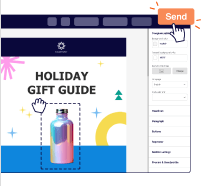B2B marketing, short for business-to-business marketing, is how companies sell products or services to other businesses. B2B marketing has a clear focus on long-term value, logic, and strategic alignment. Unlike consumer sales, the buying process in B2B marketing involves multiple stakeholders, more touchpoints, and greater scrutiny.
That means your approach needs to be smarter, more precise, and rooted in clear outcomes.
Whether you’re a SaaS provider, a professional services firm, or a manufacturer, you need to think beyond one-size-fits-all tactics. Modern B2B marketing strategies focus on delivering useful content that answers real questions. They’re built around solving problems, not selling features.
Businesses that master B2B marketing see up to 20% faster revenue growth than those that don’t. Your target audience expects relevant insights, not generic messaging, and they rely on research before making any buying decision.
This guide is built to help you meet those expectations head-on. We’ll walk through hands-on tactics, practical tips, and scalable frameworks for your marketing team.
B2B vs. B2C Marketing: Key Differences
Understanding the difference between business-to-consumer marketing and B2B marketing is key to building a focused, results-driven B2B marketing strategy. In B2C, you’re often selling to a single person making a quick, emotional decision. Think discounts, fast checkouts, and flashy ads. It’s immediate and personal, designed to convert fast.
Business-to-business marketing, on the other hand, targets potential buyers like department heads, procurement managers, and senior executives. These people are weighing long-term ROI, operational impact, and whether your solution aligns with strategic goals.
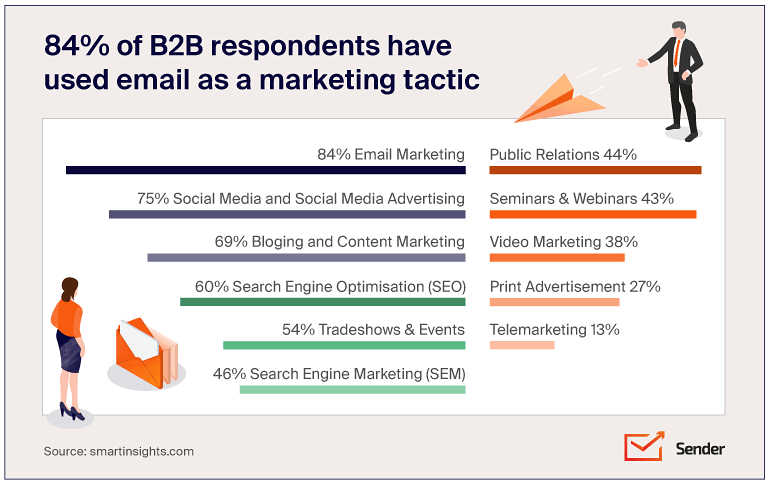
Instead of pitching products, B2B marketing focuses on solving real business problems. This means offering practical content, data-driven insights, and tools that support the buyer’s decision-making process. It’s about building trust and moving deals forward.
Unlike the linear nature of B2C, the B2B marketing funnel involves multiple touchpoints. Start with SEO blogs that address industry pain points, then offer in-depth resources, like toolkits or reports, behind lead forms. Use marketing automation and tools like a sales dialer to follow up and guide prospects toward a meeting or demo.
When it comes to marketing content, B2B marketing must be direct and helpful. Use data, product comparisons, and step-by-step explainers to guide buyers through their options. Combine this with short-form video marketing and clear CTAs to make complex solutions easier to grasp and act on.
Email marketing remains a core tactic in B2B as it offers a scalable way to nurture leads and stay top of mind. This makes it just as essential as trust-building or content authority.
5 Types of B2B Marketing
Modern B2B marketing isn’t about using one channel. It’s about combining strategies that match each stage of the buyer’s journey. New leads need education, warm prospects need nurturing, and high-value accounts often require a tailored experience.
Different decision-makers engage in different ways. Some prefer email, others respond to social or webinars. The goal is to meet them where they are with content that feels relevant.
Here are five proven strategies that drive leads, deliver increased brand recognition, and help convert your target audience.
1. Inbound Marketing
Inbound B2B marketing brings business customers to you by offering value before making a pitch. It’s about earning attention through useful, educational, and relevant marketing content that aligns with what your target audience is searching for. Did you know companies that prioritize inbound strategies are 13 times more likely to see a positive ROI?
To succeed, start with a comprehensive blog strategy targeting long-tail keywords using search engine optimization. Then, add downloadable resources like checklists or templates that solve specific problems. Create newsletters that address subscriber pain points with curated advice, product tips, and case studies.
Your B2B Marketing To-Do List:
- Use tools like Ahrefs or Google Keyword Planner to find content gaps.
- Publish weekly blog posts targeting those queries.
- Create lead magnets (eBooks, checklists) and gate them behind simple sign up forms.
- Build a nurture sequence using your email marketing platform to stay in touch.
Creating professional emails has never been easier with Sender’s drag-and-drop builder.
The best part? It’s free!
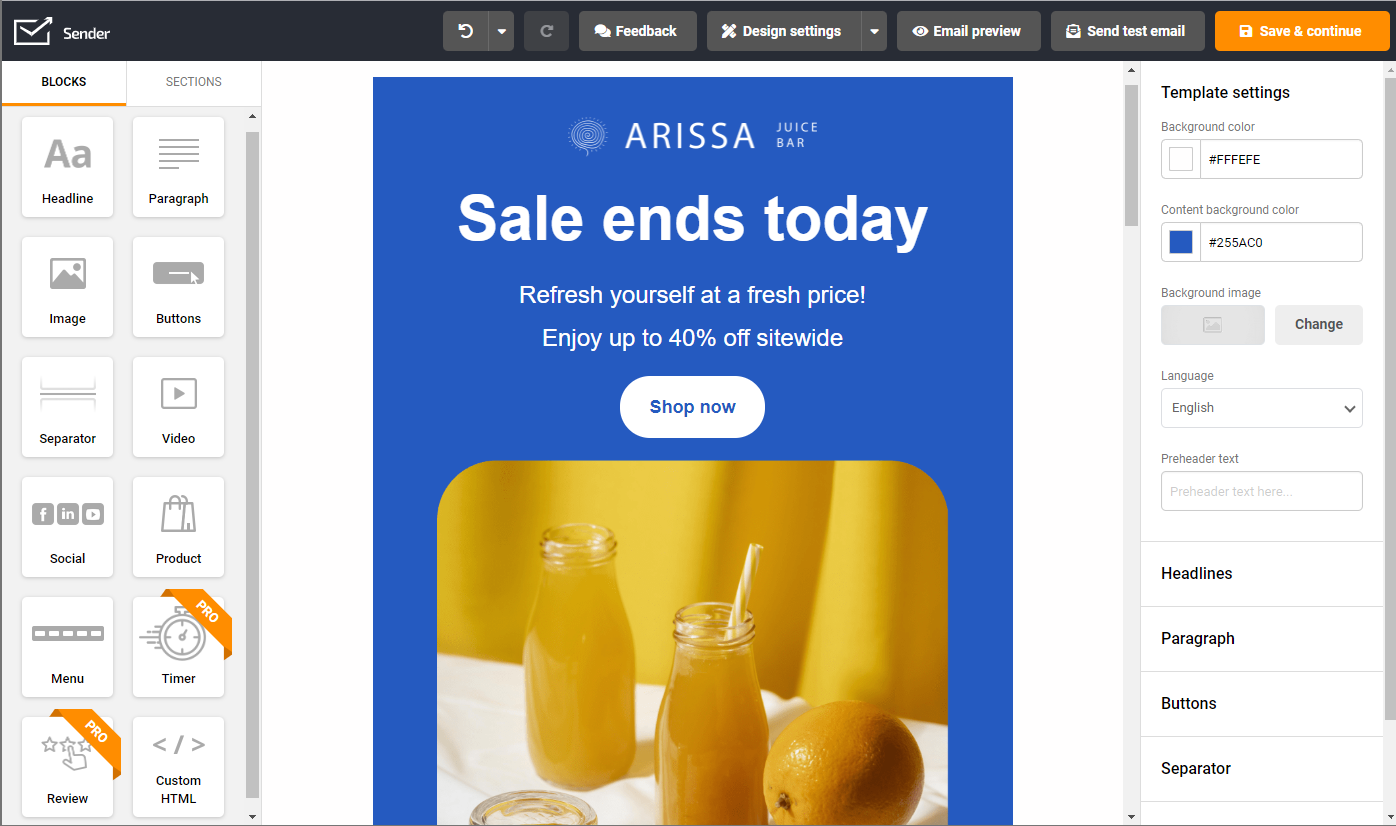
2. Outbound Marketing
Outbound B2B marketing puts your message directly in front of potential buyers. This traditional yet evolving tactic includes cold outreach, digital ads, and strategic calls. A recent study found that 82% of business buyers accept meetings after receiving a series of outbound contacts.
Unlike inbound, outbound B2B marketing initiates the conversation with the right target market. The key is precision—don’t mass-blast emails or run unfocused ads. Use lead lists, targeting tools, and personalization to make every outreach count.
Your B2B Marketing To-Do List:
- Build a list of 100 qualified companies using LinkedIn Sales Navigator.
- Craft personalized cold email sequences focused on value, not selling.
- Run Google or LinkedIn Ads that solve a clear pain point.
- Track open/click-through rates and iterate your messaging.
3. Account-Based Marketing (ABM)
Account based marketing is ideal for companies targeting a few high-value clients instead of many small leads. It means your marketing team and sales team work together to deliver highly personalized content and experiences to key accounts.
In fact, 81% of marketers say ABM delivers better ROI than other tactics. ABM isn’t just about targeting. It creates a full journey customized for each business, including landing pages, offers, and emails.
Your B2B Marketing To-Do List:
- Identify 10 high-revenue potential accounts based on deal size or strategic fit.
- Use ABM platforms like Demandbase to deliver dynamic content.
- Create landing pages tailored to each company’s pain points.
- Align your outreach with input from sales, including custom proposals.
4. Referral & Partnership Marketing
Referral and partnership marketing taps into two of your most powerful assets: satisfied clients and strategic allies. Rather than constantly seeking new leads, this approach leverages existing trust to open doors.
Referred customers are 4x more likely to engage. Equip your customer service teams with the tools and incentives to collect referrals. You’ve just turned your loyal customers into brand advocates.
Partnerships with non-competing brands allow you to cross-pollinate audiences and reach new markets more organically.
Your B2B Marketing To-Do List:
- Set up a formal referral program with tiered rewards.
- Track referrals using CRM tools to reward top sources.
- Empower account managers to request testimonials and introductions.
5. Event Marketing & Webinars
Events and webinars remain one of the most effective ways to establish credibility and foster personal connections in business to business marketing. According to Statista, 79% of digital marketers use events to generate sales leads.
While face-to-face interactions build deeper trust, online webinars allow for global participation and scalable B2B lead generation. Both serve as platforms for showcasing your team’s expertise and solutions.
Your B2B Marketing To-Do List:
- Follow up with attendees through tailored emails and content offers
- Host a webinar series with niche topics relevant to your consumers.
- Attend or sponsor industry trade shows and panel discussions.
- Invite marketing leaders to join roundtable events for knowledge exchange.
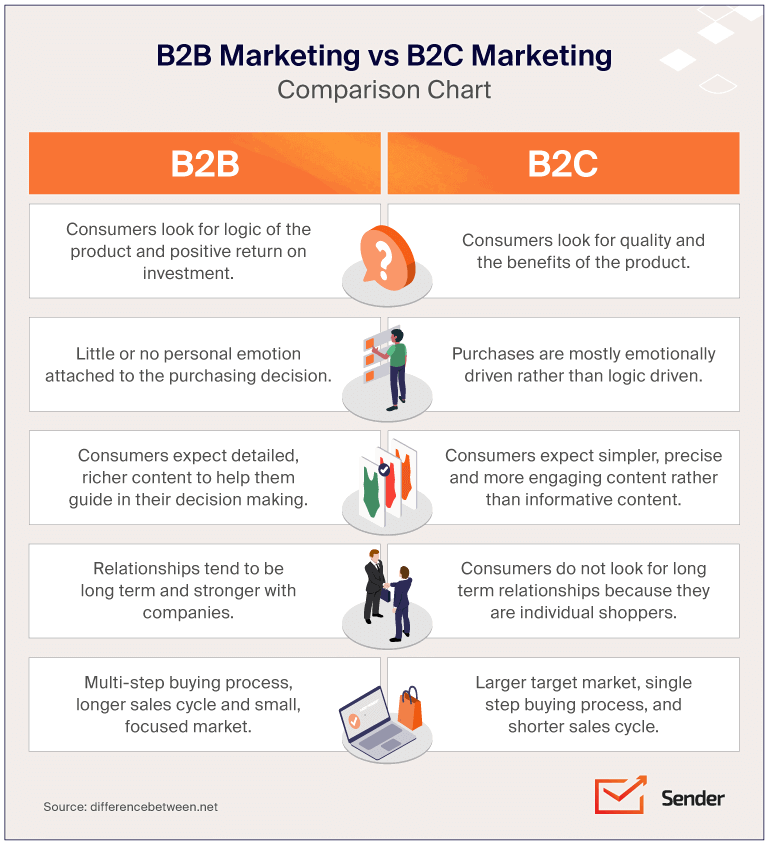
8 B2B Marketing Strategies that Work
B2B buyers are informed and selective. Flashy ads alone won’t cut it. To earn their trust, your strategy needs relevance, clarity, and real solutions.
That means knowing your audience and using the right message, channel, and timing. That could be through focused content, personalized outreach, or a smart email campaign.
Here are eight scalable strategies that work, from digital marketing and B2B SEO to account-based marketing. Each step is ideal for teams selling professional services or high-consideration solutions.
1. Research Your Target Audience’s Needs
Effective B2B marketing starts with understanding your audience. Go beyond surface-level assumptions by collecting actual behavioral and preference data. Begin by defining key customer segments based on:
- Roles,
- Industry,
- Company size,
- Other demographics (e.g., age 30–55, UK-based, mid-level tech managers).
Use free tools like Google Forms or Typeform to ask about their pain points, priorities, and preferred communication channels.
Review on-site analytics to track how they interact with your marketing content. Pages with long scroll depth or repeat visits often reflect what matters most. Add Hotjar or Microsoft Clarity to record heatmaps and session replays.
Combine this with CRM data and sales team insights to identify objections and bottlenecks in the buying process. Just make sure the data you’re pulling from your CRM is stored securely—you don’t want customer information accidentally exposed to the dark web or falling into the wrong hands.
Then, build out detailed buyer personas. Include goals, challenges, objections, and preferred channels. You can now adjust your marketing messages, campaigns, and landing page copy across all marketing channels, effectively.
Extend your knowledge here: What is Targeted Marketing? Definition, Strategies & Examples
2. Content Marketing for B2B Growth
A powerful content marketing engine begins with a full content audit. Identify your top-performing pages by reviewing analytics to see what attracts potential buyers. From there, structure a quarterly editorial calendar that supports each stage of the marketing funnel:
- Awareness
- Consideration
- Decision
When creating content, focus on how-to guides, problem-solving blog posts, and comparison articles backed by clear, simple data. Start each piece by identifying the keyword phrase your potential clients are searching for. For example, if you’re targeting CFOs or risk officers, content about digital risk, credit monitoring, and compliance will drive stronger engagement.
Use a tool like SurferSEO or Ubersuggest to map keywords to content formats. Then create an outline, optimize on-page SEO, and add internal links to key service pages.
For distribution, repurpose your blog post into a PDF summary, a short video marketing clip, or a social carousel. Promote it through emails, newsletters, and your main social media channels. Embed clear CTAs in every asset to guide your readers to take the next step toward conversion.
3. SEO and Lead Generation
To optimize your B2B SEO for lead generation, begin with a comprehensive technical SEO audit. Use tools like Screaming Frog or Google Search Console to identify and fix broken links, slow load times, or missing alt text.
Next, focus on bottom-funnel, high-intent keywords that match your target market’s purchasing behavior. Build marketing content around these keywords using a topic cluster approach. Create a long-form pillar page for each core service, then link supporting blogs to it.
This structure boosts authority and improves rankings. Refresh older blog posts with updated stats, stronger headlines, and new internal links.
The final and most important step is turning that SEO traffic into actual leads. Getting visitors to your site is great, but it doesn’t mean much if they leave without taking action. That’s where strong, helpful CTAs come in.
Instead of just saying “Contact us,” give people something they can use right away, like a template, pricing guide, or calculator. These should speak directly to the problems your buyers are trying to solve. If someone’s deep in research mode, a useful resource like that can be the nudge they need to take the next step.
The goal here isn’t just to grab their email—it’s to start a relationship by offering real value at the right time.
4. Email Marketing for B2B Success
Email is one of the most controllable and scalable marketing channels for business-to-business campaigns and brand engagement. Start by cleaning your email list and segmenting it based on:
- Buyer stage
- Industry
- Company size
- Corporate role
When crafting emails, write clear subject lines, keep your copy concise, and lead with value in the relevant content. Every email should include at least one clear CTA and reflect your brand tone. Use a dedicated email marketing platform like Sender to schedule, automate, and A/B test sequences.
Monitor open rates, click-through rates, and unsubscribes weekly, then iterate based on trends.
5. Social Media and Thought Leadership
To build influence through social media marketing, start by choosing 1–2 social media channels that align with your target audience. For B2B, LinkedIn and X are the most effective.
Post a mix of educational content, polls, product tips, and curated industry news. Humor will go a long way in making your posts relatable to your audience. Make them skimmable with short paragraphs or emojis, and always end with a question or CTA.
Your marketing team should respond to comments, send DMs, and engage with relevant hashtags. Plan a monthly live Q&A or go behind-the-scenes with short-form video marketing content. If you’re stuck for content ideas, repurpose blog posts into quote graphics or carousel slides.
Track post performance to learn what resonates and double down on high-performing formats. Building authority takes consistency. So commit to a schedule and stay visible in your niche.
6. Paid Advertising for B2B Growth
To get the most out of your digital marketing budget, set up structured ad campaigns focused on solving customer pain points. Begin with keyword research in Google Ads, targeting bottom-of-funnel phrases.
For LinkedIn, create audience segments based on industry, job title, location, and company size. Craft short, specific ad copy that speaks directly to a business problem and leads to a relevant landing page.
Include a strong, measurable CTA like “Download Free Report” or “Schedule a Demo”. Always run A/B tests with variations in headlines and visuals. Use retargeting ads to re-engage visitors who didn’t convert the first time.
Here’s a list of what metrics to review for your ad performance every week:
- Click-through rate (CTR)
- Cost per click (CPC)
- Conversion rates
That’ll help identify what’s working and where the budget can be reallocated.
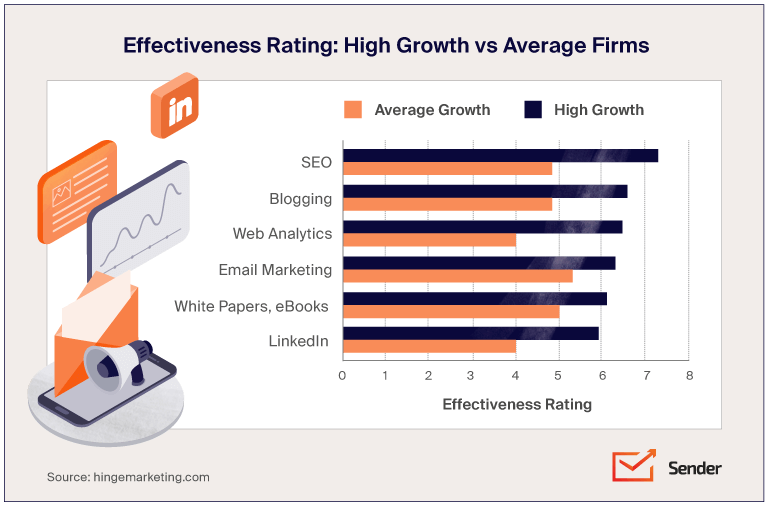
8. Personalization for High-Value Clients
Personalization is essential when targeting high-value clients with specific needs. Start by using your CRM or email marketing platform to segment contacts based on each stage of the buying process. Develop messaging tailored to these segments and incorporate that into dynamic email campaigns.
Next, create landing pages that directly address the challenges of each audience group. These should include:
- Custom headlines that engage and resonate
- Benefit-driven copy to keep the audience’s interest
- Calls to action that reflect the visitor’s role or industry.
For example, a finance lead may want to understand how your service addresses digital footprint risks or includes identity theft protection for their clients.
Use marketing automation to deliver follow-up content based on interactions. For example, send a case study after someone clicks a demo request.
To manage this at scale, use platforms like HubSpot or Marketo to integrate audience behaviour, intent signals, and personalised workflows. This approach keeps your marketing messages relevant, timely, and highly engaging across all marketing channels.
Examples of Successful B2B Marketing Strategies
Anyone can talk about strategy—but seeing it in action is where the real lessons lie. The most successful brands don’t rely on guesswork or outdated tactics. They craft deliberate, data-driven B2B marketing campaigns that resonate with their audience, foster trust, and deliver measurable results.
In a landscape where just 0.78% of B2B leads are converted into actual deals, competition is tough. Companies now know that it takes more than a great product to win deals. It requires a seamless blend of:
- Content marketing to educate
- Account-based targeting for precision
- Thought leadership to build authority.
The secret is mastering the fundamentals of B2B marketing and executing them better than anyone else.
HubSpot: Mastering Content Marketing with Inbound Power
When it comes to content marketing, HubSpot sets the standard. The platform is known for offering free, valuable resources like blogs, templates, and webinars. HubSpot attracts over 7 million monthly visitors and generates 70% of its leads through inbound marketing.
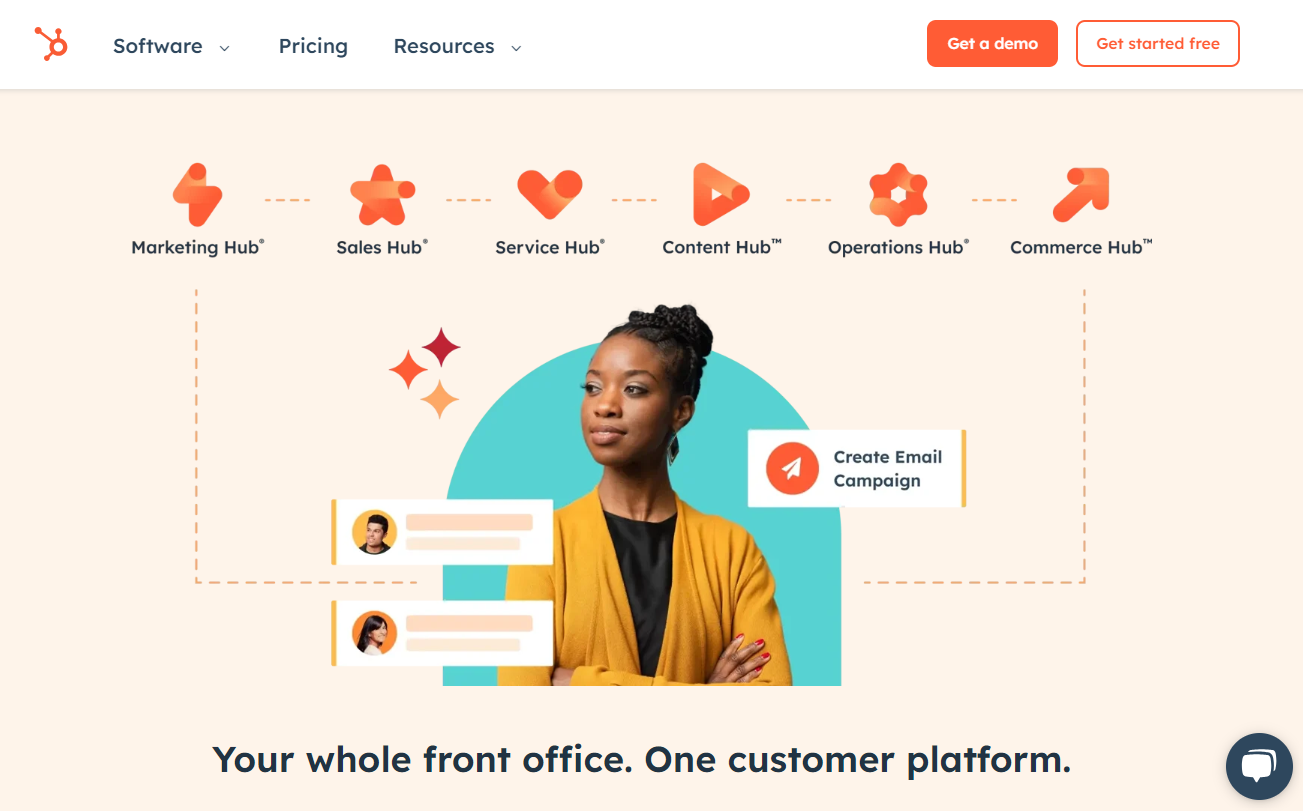
HubSpot also helps brands move leads through the funnel by doing what it does best: offering useful content at just the right moment. It combines blog posts that rank in search, lead magnets like templates or checklists, and smart email workflows that follow up based on what someone clicks or downloads. That way, every step feels helpful, not pushy. Just the kind of trust-building buyers appreciate.
Another key benefit is that HubSpot helps shorten sales cycles by giving buyers the knowledge they need to make confident decisions, often before they ever talk to sales. With resources like HubSpot Academy, interactive product demos, and detailed blog guides, buyers can self-educate at their own pace.
This approach saves companies time and ad spend by using inbound marketing and automation tools like lead scoring, email workflows, and CRM tracking to keep the process moving smoothly.
HubSpot built its success through consistent, high-value content marketing. Here’s how you can shorten sales cycles, save ad spend, and keep your marketing strategy working 24/7:
- Create a resource library including guides, checklists, and webinars.
- Use SEO-driven blogs to capture traffic, then nurture leads using a robust email sequence.
- Build topic clusters for every stage of the marketing funnel.
- Automate your follow-up using your email marketing platform to deliver relevant content based on behaviour.
Salesforce: Account-Based Marketing Done Right
Salesforce uses account-based marketing to engage enterprise clients through highly personalized campaigns. Their strong alignment between marketing and sales teams delivers tailored messaging that speaks directly to decision-makers.
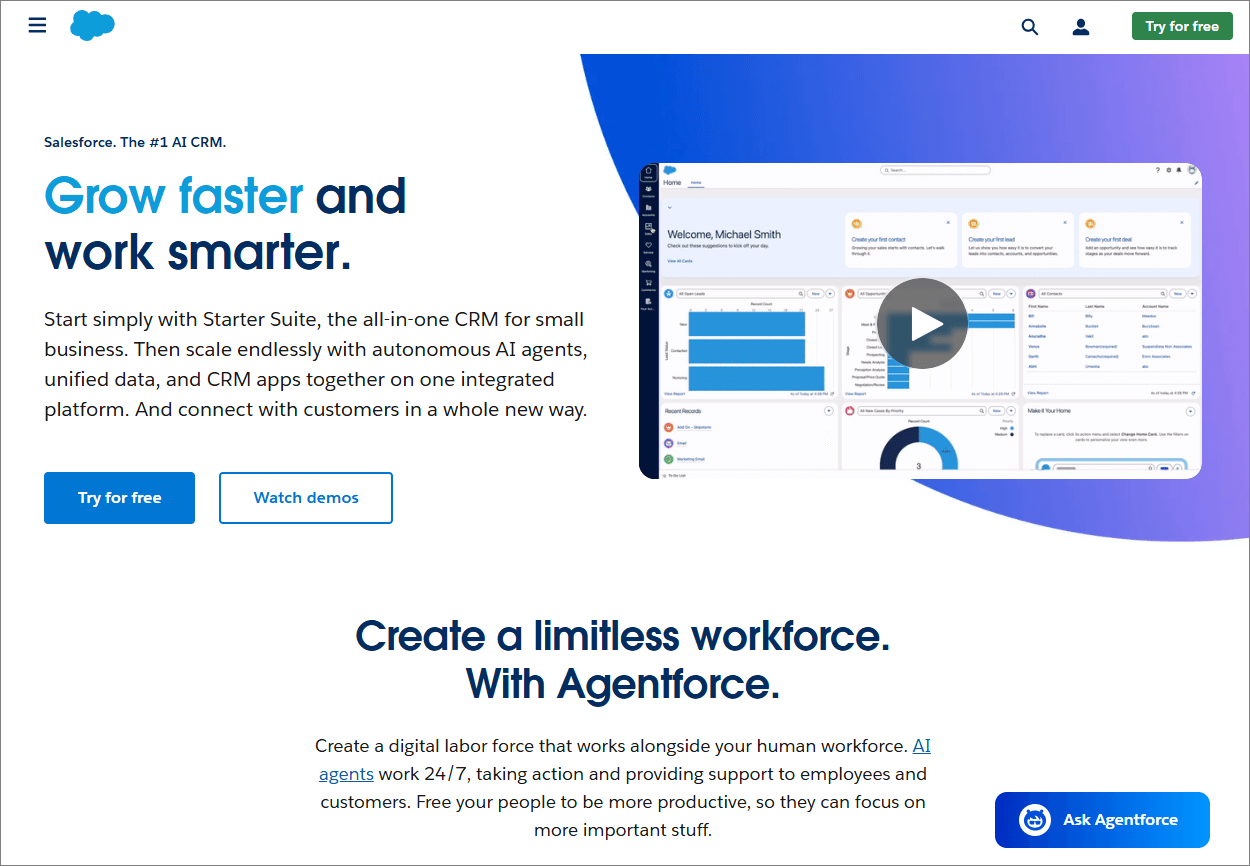
Salesforce’s approach to account-based marketing doesn’t stop there. The platform helps businesses improve lead quality and shorten sales cycles. It enables account managers to boost customer retention through precise targeting.
With Salesforce, companies can track key accounts, automate outreach, and deliver consistent experiences. That’s the basis of driving better B2B marketing results and maximizing ROI.
Here’s how you can customize every touchpoint for the key decision-makers in target accounts:
- Identify 5–10 high-value accounts and build individual outreach plans.
- Create custom landing pages and proposals that speak directly to each company’s pain points.
- Use CRM data for personalization and automate follow-up touchpoints.
- Align marketing and sales through shared metrics and regular check-ins.
Even without a Salesforce-sized team, companies can use free or low-cost tools to launch lean ABM pilots. This shows how ABM transforms outreach from broad campaigns to precision-targeted strategies.
Ahrefs: Building Trust Through Thought Leadership
Ahrefs has built a reputation as one of the most respected brands in SEO, and a big part of that success comes from how they approach B2B marketing. Instead of relying on ads or aggressive sales tactics, they focus on building trust through education and transparency.
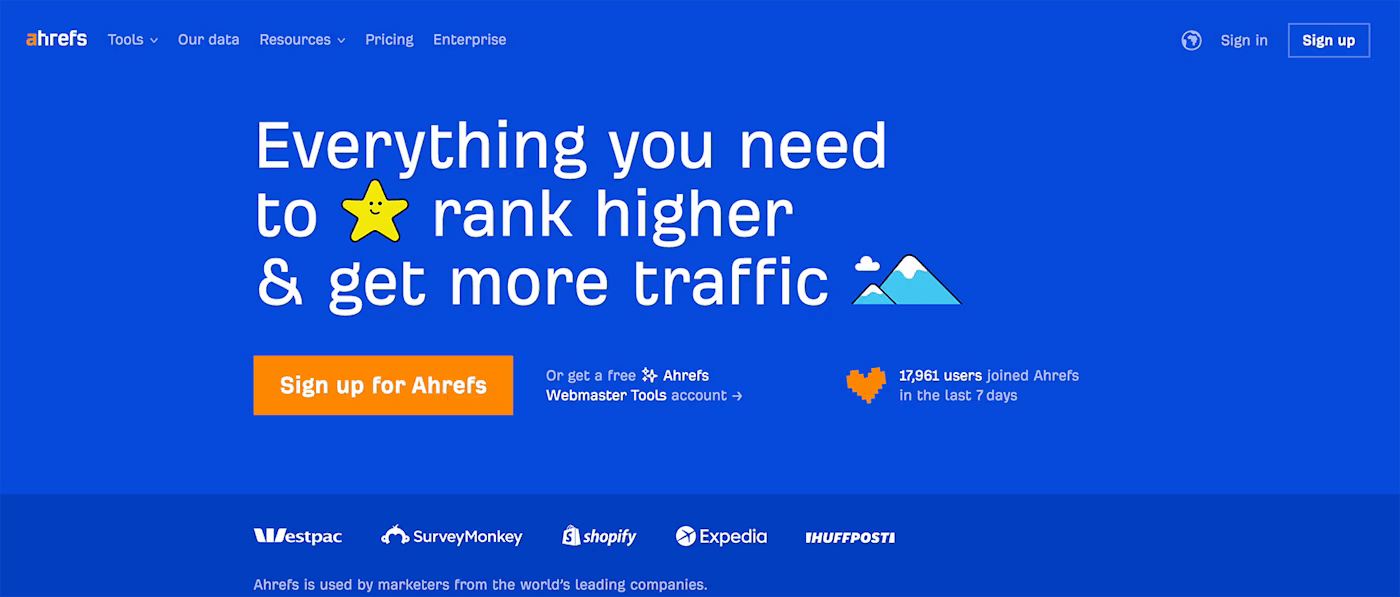
One great example is Tim Soulo, Ahrefs’ CMO. On LinkedIn, Tim shares actionable SEO insights, content strategy tips, product updates, and behind-the-scenes looks at Ahrefs’ milestones.
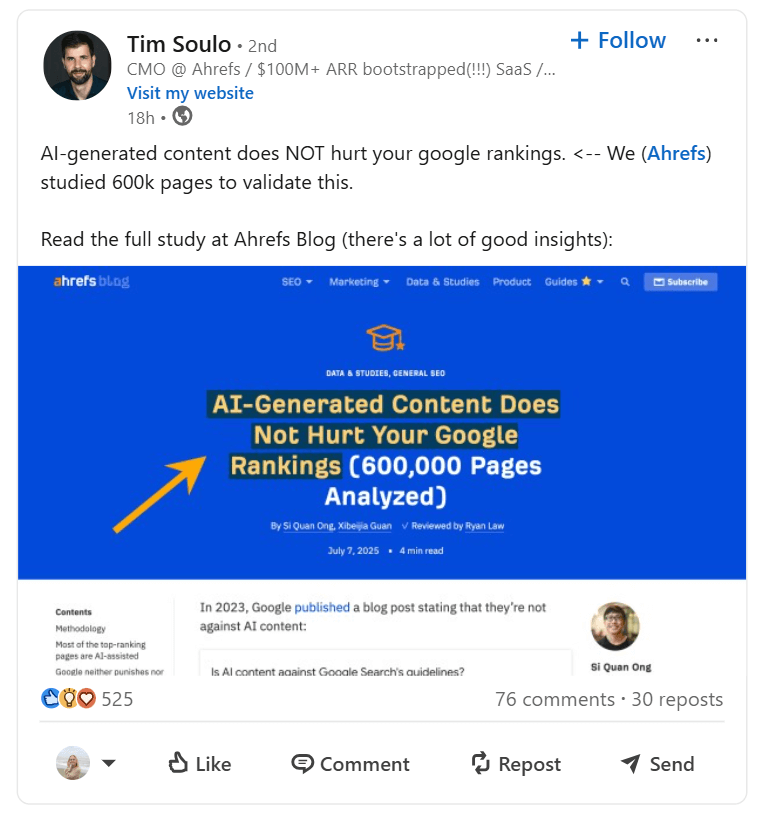
His posts regularly spark meaningful conversations among B2B marketers, SaaS founders, SEO consultants, and digital agencies. That level of engagement has helped position Ahrefs not just as a tool, but as a go-to resource in the industry.
Ahrefs shows how a strong personal brand, combined with educational, relevant content, can power a broader marketing strategy. They’ve created an ecosystem of loyal users, word-of-mouth referrals, and organic growth.
Here’s how to take a page from Ahrefs’ playbook:
- Encourage your leadership team to post regularly on LinkedIn about product learnings, market trends, or customer wins.
- Share milestones transparently to build trust and spark interest.
- Use real-world insights and honest takes. This stands out more than polished corporate messaging.
Ahrefs proves that successful B2B marketing isn’t about volume—it’s about value. Thought leadership, when done consistently and authentically, can shape your brand perception and strengthen your position in a crowded market.
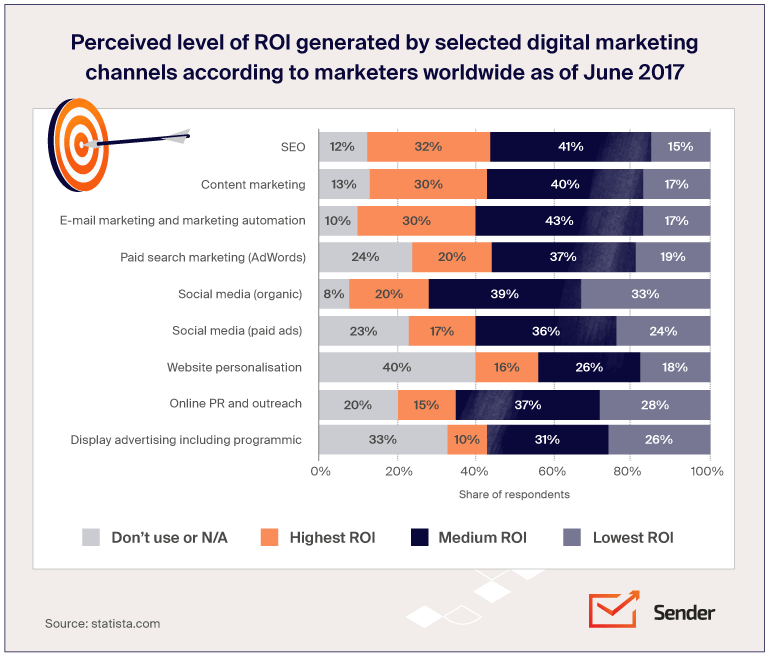
Emerging Trends in B2B Marketing
B2B marketing has evolved far beyond basic emails, influencer marketing and static brochures. Today’s potential buyers expect smarter, faster, and more personalized experiences. This is in line with advancements in marketing technology and changing customer expectations.
Modern B2B marketing is about creating meaningful connections. That requires delivering the right message, at the right time, through the right channels. It’s no longer just about visibility, it’s about relevance, trust, and value.
To stay competitive, businesses must innovate and focus on customer engagement. Learning about and adapting to the trends shaping the future of B2B marketing keeps you on top and relevant.
Here’s what forward-thinking companies are doing to lead the way, and practical steps so you could do the same:
1. Smarter AI and Automation
Integrate AI into your marketing strategy using tools like ChatGPT or Jasper to generate tailored copy for emails, landing pages, and social posts.
Use AI-powered platforms for smarter segmentation and lead scoring, and automate nurture campaigns using workflows inside your email marketing platform. This saves time and ensures your marketing messages reach the right segment at the right time.
2. Interactive and Video Content
Develop interactive tools like quizzes, budget calculators, or self-assessments to make decisions hassle-free.
Pair these with video marketing content that explains your solution in 60–90 seconds. Tools like Loom or Vidyard can help your marketing team create personalized video follow-ups.
3. Personalization and Privacy
Shift away from third-party cookies and collect first-party data through gated content or newsletter sign-ups. Be transparent about data collection, and ensure your business-to-business marketing aligns with privacy regulations like GDPR. Use the data to personalize CTAs and dynamic website content.
4. New Preferred Channels
Do you know where your ideal business customers are hanging out? They are spending more time in Slack groups, private LinkedIn communities, and niche podcasts.
Identify 2–3 of these high-trust channels and start participating or sponsoring content. This should be a formal part of your online marketing plan and tracked for engagement metrics.
These trends aren’t optional—they’re foundational shifts in the core of B2B marketing. Hopping on now will keep you competitive, compliant, and connected.
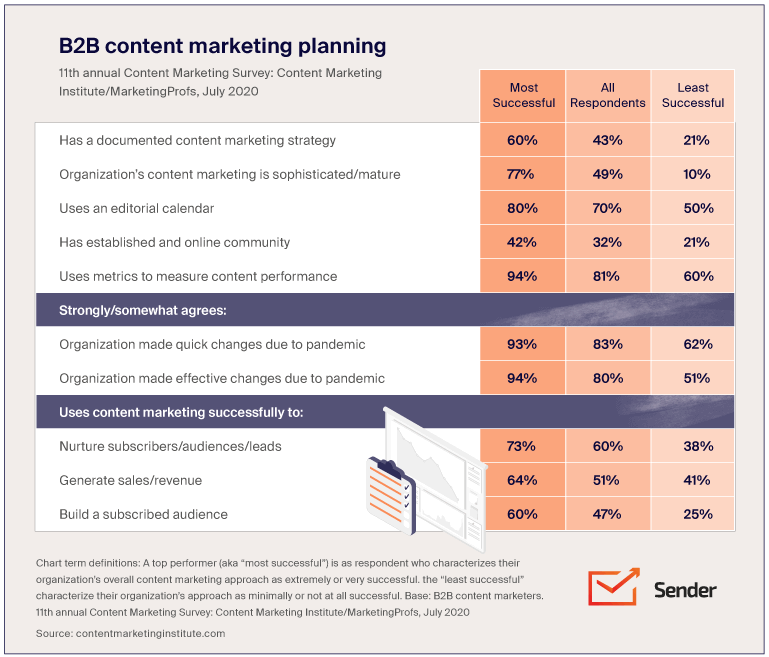
Invest in B2B Marketing to Increase Your Customer Base
In today’s competitive market, B2B businesses need more than just visibility. They need a strategy that resonates with modern buyers. Long sales cycles and complex decision-making mean your marketing efforts must guide prospects through the sales funnel with relevance, trust, and value.
The most effective marketing teams do more than generate leads—they build relationships. From personalized campaigns to social media engagement, every touchpoint should be designed to educate, support, and convert. And the results speak for themselves: companies with a clear strategy see significantly better lead conversions, customer retention, and long-term revenue growth.
Email marketing is one of the most powerful tools for achieving this, and Sender makes it easy. With affordable plans, built-in automation, and a Free Forever plan that lets you send up to 15,000 emails a month, Sender helps your team reach business buyers at the right time. Setup is quick, with no hidden fees or credit card required.
